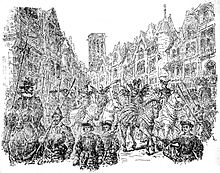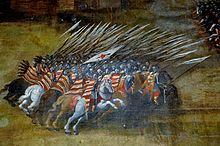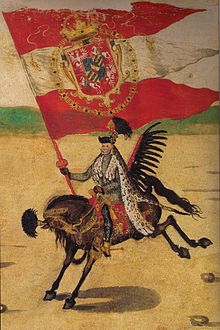Polish hussars
| Polish hussars | |
|---|---|
Shock attack | |
| Nickname(s) | The Angels of Death[1] |
| Motto(s) | Amor Patriae Nostra Lex (Love of the fatherland is our law) |
| Colors | Red and white |
| Equipment | Burgonet, lance, mace (bludgeon), hatchet, sabre |
| Engagements | Tree list
|
The Polish hussars (/həˈzɑːrs/; Polish: husaria [xuˈsarja]),[a] alternatively known as the winged hussars, were a heavy cavalry formation active in Poland and in the Polish–Lithuanian Commonwealth from 1503 to 1702. Their epithet is derived from large rear wings, which were intended to demoralize the enemy during a charge. The hussars ranked as the elite of Polish cavalry until their official disbanding in 1776.
The hussar dress was ostentatious and comprised plated
The early
The hussar formation proved effective against
History

The etymology of the word hussar stems from the Serbian word gusar meaning "wanderer/brawler".
The oldest reference of hussars in Polish records dates to the year 1500, when the Rascians were employed by Grand Treasurer

The first hussar formation was established by the decree of the

The true winged hussar arrived with the reforms of the
Over the course of the 16th century, hussars in
With the
Over time, the role of the Hussar evolved into a reconnaissance and advanced scout capacity. Their uniforms became more elaborate as their armour and heavy weapons were abandoned. In the 18th century, as infantry firearms became more effective, heavy cavalry, with its tactics of charging into and breaking infantry units, became increasingly obsolete and hussars transformed from an elite fighting unit to a parade one.
Instead of ostrich feathers, the husaria men wore wooden arcs attached to their armour at the back and raising over their heads. These arcs, together with bristling feathers sticking out of them, were dyed in various colours in imitation of laurel branches or palm leaves, and were a strangely beautiful sight to behold ... – Jędrzej Kitowicz (1728–1804).[10][11]
Tactics

The hussars represented the heavy cavalry of the Commonwealth. The
The Polish hussars' primary battle tactic was the mounted
Armour and weaponry
-
Hussar half-armour from the mid-17th century, National Museum in Kraków.
-
Hussar armour, dating to the first half of the 17th century, Polish Army Museum in Warsaw.
-
Scale armour of King John III Sobieski.
-
Polish hussar sabre (Polish "szabla").
-
Burgonet-style hussar helmet, Wawel Castle
-
Hussar lobster-tailed pot helmet with side wings, Wawel Castle
The hussars'
The

The
Hussars sometimes carried additional weapons, such as a 'nadziak' (
Individual hussars may have possibly carried a
At the height of their prowess, from 1576 to 1653, hussar armour consisted of a comb-like
The hussar armour was light, usually around 15 kilograms (33 lb), allowing them to be relatively quick and for their horses to gallop at full speed for long periods. Albeit from the 1670s onwards, chain-mail was used when fighting the Muslim Tatars in the southeastern borderlands of the Commonwealth. A rarely-used
The

Legacy
The Polish hussars are depicted on the commemorative 500 złotych gold coin.[14]

The badge of the Polish Army's 11th Armoured Cavalry Division features a stylized hussar wing and helmet.[15] The Division's patron is Jan III Sobieski, who led the winged hussars at the Battle of Vienna, and the unit's commemorative badge is inscribed with the inherited battle honour "Vienna 1683".[15]
In 2016, the Swedish metal band Sabaton wrote the song "Winged Hussars" for their album The Last Stand. The song is about the Battle of Vienna in 1683 and the Hussars' charge which helped defeat the Ottomans.[16]
One, then two for one scene, were featured in the Canadian TV series Murdoch Mysteries, in the 2018 season 11 episode 16 entitled, "Game of Kings".
In 2023, in the Netflix series 1670, Bogdan is seen wearing the winged hussars in Season 1 Episode 1, "The Assembly".
See also
- Polish cavalry
- Towarzysz
- Towarzysz pancerny
- Poczet
- Offices in the Polish–Lithuanian Commonwealth
Notes
References
Citations
- ^ Marek Kępa 2017.
- ^ Showalter & Astore 2007, p. 44
- ^ Nicolle & Sarnecki 2008, p. 19
- ^ Nolan 2006, p. 428
- ^ Hientze 2018, p. 2
- ^ a b Davies 2012, p. 7–
- ^ Plewczyński 1994, p. 47
- ^ Brzezinski 1987, p. 14
- ^ Plewczyński 1995, pp. 109, 215
- ISBN 8322326823.
- ^ Kitowicz, Jędrzej (1855). Opis obyczajów i dziejów za panowania Augusta III [Description of customs and history during the reign of Augustus III] (in Polish). Petersburg i Mohylew: Bolesław M. Wolff.
- ^ "Husaria w Kętrzynie" [Hussars in Kętrzyn]. Hodowca i Jeździec (in Polish). October 4, 2012.
- ^ Sikora, Radosław (17 January 2019). "Ciekawostki na temat husarii, o których nie uczyli Cię w szkole" [Interesting facts about hussars that you were not taught about in school]. Ciekawostki Historyczne (in Polish). Retrieved 10 June 2021.
- ^ "Husarzy na monetach" [Hussars on coins]. Onet Wiadomosci (in Polish). Retrieved 10 July 2021.
- ^ a b "11th Lubuska Armored Cavalry Division: Colours and symbols". Wojsko Polskie. Retrieved 2022-11-23.
- ^ "Winged Hussars – Lyrics". Sabaton.net. Retrieved 10 July 2021.
Bibliography
- Broń i barwa w Polsce [Arms and colors of Poland] (in Polish). Muzeum Narodowe w Krakowie. 2004.
- Bocheński, Zbigniew (1960). "Ze studiów nad polską zbroją husarską" [Studies on Polish hussar armor]. Rozprawy I Sprawozdania Muzeum Narodowego W Krakowie (in Polish). VI. Kraków. ISSN 0069-2298.
- Brzezinski, Richard (1987). Polish Armies (1): 1569–1696. ISBN 0-85045-736-X.
- Brzezinski, Richard (2006). Polish Winged Hussar, 1500-1775. Illustrated by Velimir Vuksic. Oxford, UK: Osprey. ISBN 1-84176-650-X.
- Bystroń, Jan S. (1932). Dzieje obyczajów w dawnej Polsce [The history of customs in old Poland] (in Polish). Warszawa: Państwowy Instytut Wydawniczy.
- Cichowski, Jerzy & Szulczyński, Andrzej (1981). Husaria (in Polish). Warszawa: ISBN 83-11-06568-3.
- Davies, Brian L. (2012). Warfare in Eastern Europe, 1500-1800. ISBN 978-90-04-22198-7.
- Drożdż, Piotr (2000). Orsza 1518. Historyczne bitwy (in Polish). Warszawa: Bellona.
- Gembarzewski, Bronisław (1999). Husarze: ubiór, oporządzenie i uzbrojenie 1500–1775 [Hussars: uniforms, equipment and weapons 1500–1775] (in Polish). Warszawa: Wydawnictwo Arkadia. ISBN 83-88055-01-1.
- Hientze, Ian von (2018). The War Chronicles of Jerry Dobiecki. United States of America: Pike and Powder Publishing Group. ISBN 978-1-945430-96-1.
- Kaczmarek, Krystyna; Kaczmarek, Remigiusz & Kaczmarek, Romuald (2005). "Jan Sobieski jako żołnierz i wódz we współczesnej mu grafice, cz. 2" [Jan Sobieski as a soldier and commander in contemporary artworks, part 2]. Wychowanie Techniczne w Szkole (Z Plastyką) (in Polish) (2): 39–42. ISSN 0510-9884.
- Kaczmarek, Romuald (2005). "Jan Sobieski jako żołnierz i wódz we współczesnej mu grafice, cz. 1" [Jan Sobieski as a soldier and commander in contemporary artworks, part 1]. Wychowanie Techniczne w Szkole (Z Plastyką) (in Polish) (1): 26–29. ISSN 0510-9884.
- Kwaśniewicz, Włodzimierz (2003). Leksykon broni białej i miotającej [Lexicon of bladed and throwing weapons] (in Polish). Warszawa: Bellona. ISBN 83-11-09617-1.
- Nagielski, Mirosław (1999). Relacje wojenne z pierwszych lat walk polsko-kozackich powstania Bohdana Chmielnickiego okresu "Ogniem i mieczem" (1648–1651) [War reports from the first years of Polish-Cossack fights in the uprising of Bohdan Chmielnicki during the "With Fire and Sword" period (1648–1651)] (in Polish). Warszawa: Viking. ISBN 83-912638-0-0.
- Nicolle, David & Sarnecki, Witold (2008). Medieval Polish Armies 966-1500. Men-at-Arms. Oxford: Osprey. ISBN 978-1-84603-014-7.
- Nolan, Cathal J. (2006). The Age of Wars of Religion, 1000-1650: An Encyclopedia of Global Warfare and Civilization. London, UK: ISBN 978-0-313-33733-8.
- ISBN 83-06-01577-0.
- Plewczyński, Marek (1994). Obertyn 1531 (in Polish). ISBN 83-11-08287-1.
- Plewczyński, Marek (1995). W służbie polskiego króla [In the service of the Polish king] (in Polish). OCLC 164904999.
- Podhorodecki, Leszek (1988). Chocim 1621. Historyczne bitwy (in Polish). Warszawa: Wydawnictwo Ministerstwa Obrony Narodowej. ISBN 978-8-311075177.
- Sawicka, Zuzanna (2002). Koń w życiu szlachty w XVI-XVIII w. [The horse in the life of the nobility in the 16th-18th centuries] (in Polish). ISBN 83-7174-839-6.
- Showalter, Dennis; Astore, William (2007). The Early Modern World - Soldier's Lives Through History. United States of America: Greenwood Press. ISBN 978-0-313-33312-5.
- Sikora, Radosław (2003). Fenomen husarii [The Phenomenon of Hussars] (in Polish). Toruń: Duet. ISBN 83-918712-8-2.
- Sikora, Radosław (2010). Kłuszyn 1610 (in Polish). Warszawa: Instytut Wydawniczy Erica. p. 160. ISBN 978-83-62329-05-2.
- Sikora, Radosław (2005). Lubieszów 17 IV 1577 (in Polish). ISBN 83-89943-05-0.
- Sikora, Radosław (2010). Z Dziejów husarii [Of the History of Hussars] (in Polish). Warszawa: Instytut Wydawniczy Erica. ISBN 978-83-62329-04-5.
- Sikora, Radosław & Musialowicz, Bartosz (October 2016). "Winged Hussars". Business Ukraine: 30–34. .
- Sikorski, Janusz, ed. (1965). Zarys dziejów wojskowości polskiej do roku 1864, t.1 [An outline of the history of the Polish military until 1864, Vol. 1] (in Polish). Warszawa: Wydawnictwo Ministerstwa Obrony Narodowej.
- Szcześniak, Robert (2008). Kłuszyn 1610. Historyczne bitwy (in Polish) (2nd ed.). Warszawa: Bellona. ISBN 978-8-311110953.
- Teodorczyk, Jerzy (1966). "Bitwa pod Gniewem 22.IX – 29.IX. 1626, pierwsza porażka husarii ["The Battle of Gniew 22–29 September 1626, The First Defeat of the Hussars"]". Studia i materiały do Historii Wojskowości, t. XII [Studies and materials for the history of the military, Vol. XII] (in Polish). Warszawa: Wojskowy Instytut Historyczny.
- Wisner, Henryk (1987). Kircholm 1605. Historyczne bitwy (in Polish). Warszawa: Wydawnictwo Ministerstwa Obrony Narodowej. ISBN 978-8-311073876.
- ISBN 83-01-02515-8.
- Żygulski, Zdzisław (1998). Broń wodzów i żołnierzy [The weapons of commanders and soldiers] (in Polish). Kraków: Wydawnictwo Kluszczyński.
- Żygulski, Zdzisław (2000). Husaria polska [Polish hussars] (in Polish). Warszawa: Wydawnictwo Pagina. ISBN 978-8-386951314.
- Marek Kępa (27 December 2017). "Poland's Winged Knights: From Invincible Glory To Obsolescence". Culture.pl. Retrieved 12 February 2024.
External links
- Reenactment a Polish reenactment information site.[dead link]
- Polish Hussar Replica vs Antique Understand the difference in Polish hussar Replica & Antique.[dead link]
- Husaria.us a Los Angeles-based Polish Hussar reenactment group and reference library.
- [1] The first Los Angeles based website for this portrayal.[dead link]
- About hussar's armour (Polish).[dead link]
- Polska Husaria: The Cavalry of the Polish Winged Hussars (video)[dead link]







